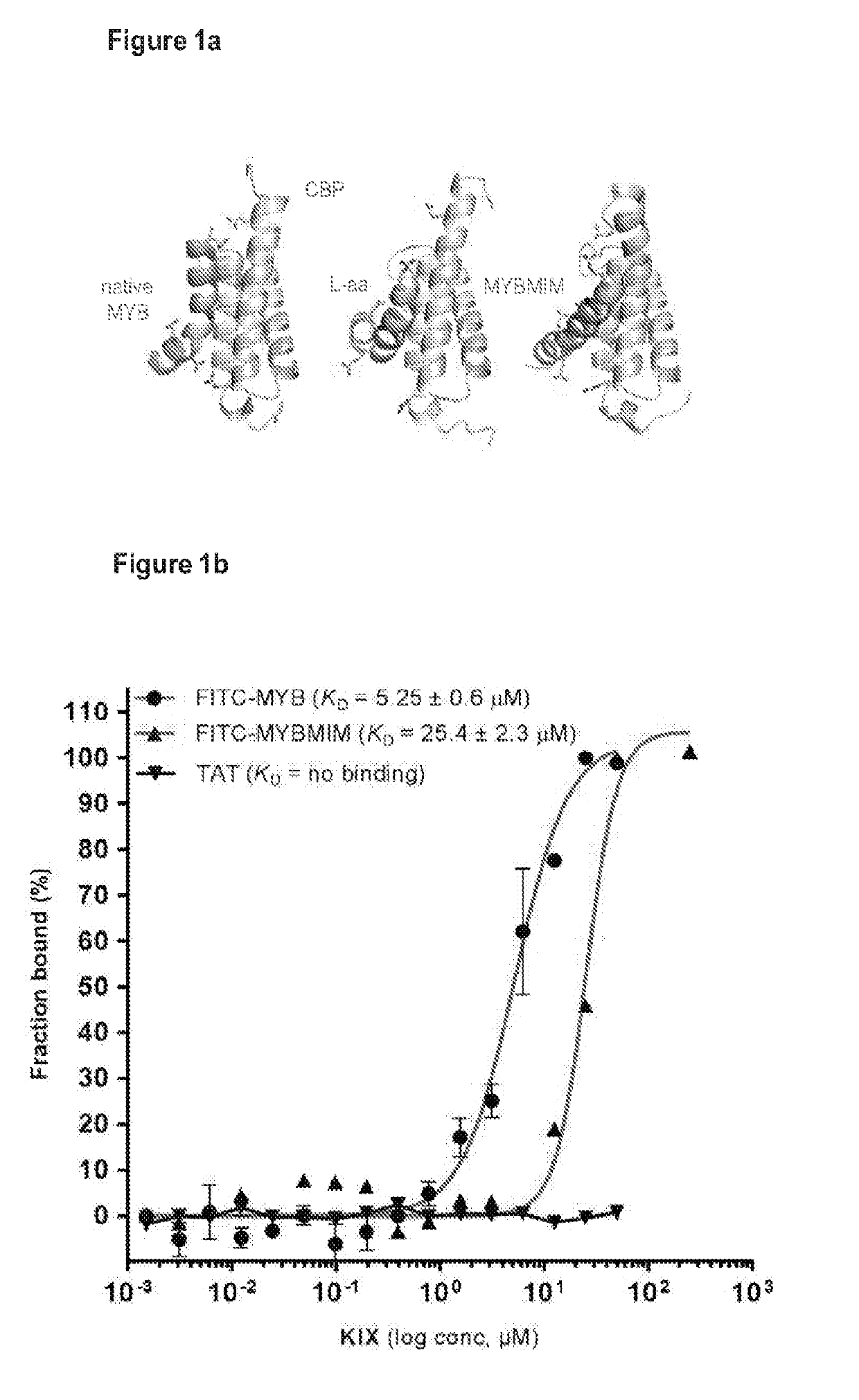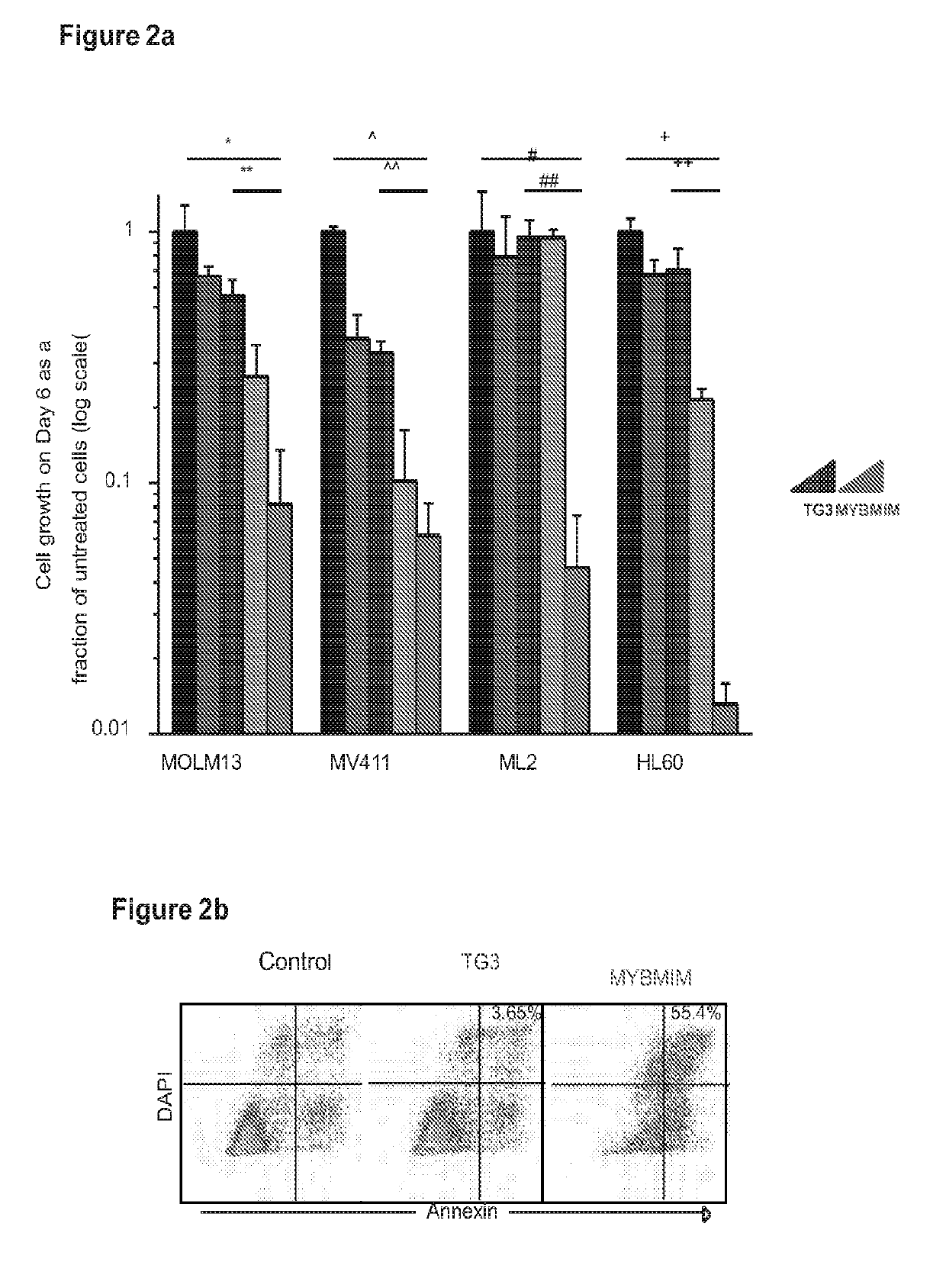Agents and methods for treating cbp-dependent cancers
a technology of cbp-dependent cancer and agents, which is applied in the direction of peptide/protein ingredients, drug compositions, peptide sources, etc., can solve the problems of affecting the activity of leukemogenic mybs, affecting the survival rate of patients with high-risk molecular features, and not having significant improvement in the treatment of pediatric and adult acute myeloid leukemia (aml)
- Summary
- Abstract
- Description
- Claims
- Application Information
AI Technical Summary
Benefits of technology
Problems solved by technology
Method used
Image
Examples
example 1
ompetes with the MYB:CBP Complex in AML
[0148]Through molecular modeling, there is in vitro binding of engineered L-amino acid (L-aa; SEQ ID NO:2) and D-amino acid (Daa; SEQ ID NO:1) containing peptides to CBP (FIG. 1a). Both Laa and Daa peptides were conjugated to FITC by the Tufts University Core Facility. Through plasmid DNA isolation from a pGEX backbone, the KIX domain of CBP was purified and utilized to determine binding affinity to both FITC-conjugated peptides. Using the NanoTemper NT 115 instrument, binding affinity was established in a microscale thermopheresis binding assay (FIG. 1b). The rapid and efficient intracellular penetration of a FITC-conjugated peptide (SEQ ID NO:6) in a human AML cell line using confocal microscopy was demonstrated. There is intranuclear penetration of the FITC-conjugated peptide after incubation with 50 nM concentration of peptide for 20 minutes indicated by the FITC-Hoechst overlay (FIG. 1c). In a biochemical pull-down assay, using biotinylate...
example 2
ownregulates MYB-Regulated Genes and Induces Apoptosis
[0150]Treatment of human AML cell lines with MYBMIM in vitro reveals an induction of AML cell death that is seen in MOLM13, MV411, ML2, and HL60 cell lines in a dose-dependent effect with MYBMIM, 10 μM and 20 μM doses, as compared to its inactive isostere TG3, 10 μM and 20 μM doses (FIG. 2a). Flow cytometric analysis of apoptosis using Annexin-V APC staining in MV411 cells in vitro with MYBMIM treatment at 20μM dose for 24 hours (FIG. 2b) reveals an induction of apoptosis. Morphological changes are evident in Wright-Giemsa stains of cytospun MV411 cells with cell death seen at 40× immersion oil microscopy (FIG. 2c). In trying to identify the downstream gene expression effects of MYBMIM in human AML cells, human AML cells were treated for six hours with the MYBMIM peptide, using both TG3 inactive peptide and control untreated cells as negative controls. RNA-seq data reveals significant down-regulation of MYB-dependent gene express...
example 3
xhibits Anti-Leukemic Efficacy In Vivo
[0152]The anti-leukemic therapeutic efficacy of the MYBMIM peptide was investigated using a primary patient derived xenograft model. In this model, 5×105 cells of a primary MLL-rearranged AML were transplanted via tail vein injection into sublethally irradiated NSG mice. In one xenograft model, after peripheral blood engraftment was confirmed (range of 1-7% hCD45), mice were randomized to cohorts (n=15) of either treatment with MYBMIM (25 mg / kg daily) or vehicle, all via intraperitoneal injection for 21 days. At the end of the treatment period, bilateral femurs were harvested, formalin fixed, paraffin embedded, and sectioned for Immunohistochemical staining of hCD45. In this analysis of bone marrows using hCD45 staining, MYBMIM induces a decrease in the leukemia burden in mice. Representative images are shown using 40× magnification (FIG. 4b). In a subsequent xenograft experiment, 5×105 cells of a primary MLL-rearranged AML were transplanted via...
PUM
| Property | Measurement | Unit |
|---|---|---|
| pH | aaaaa | aaaaa |
| pH | aaaaa | aaaaa |
| peak power | aaaaa | aaaaa |
Abstract
Description
Claims
Application Information
 Login to View More
Login to View More - R&D
- Intellectual Property
- Life Sciences
- Materials
- Tech Scout
- Unparalleled Data Quality
- Higher Quality Content
- 60% Fewer Hallucinations
Browse by: Latest US Patents, China's latest patents, Technical Efficacy Thesaurus, Application Domain, Technology Topic, Popular Technical Reports.
© 2025 PatSnap. All rights reserved.Legal|Privacy policy|Modern Slavery Act Transparency Statement|Sitemap|About US| Contact US: help@patsnap.com



